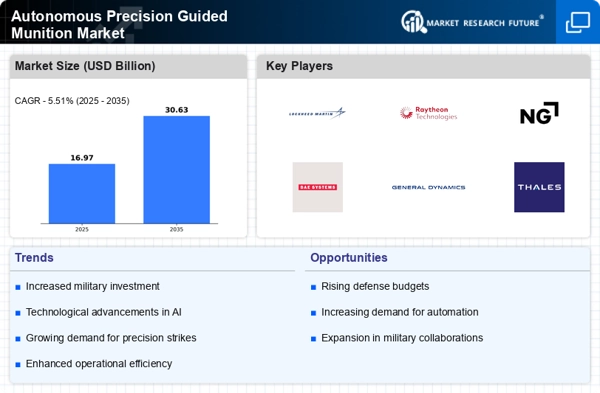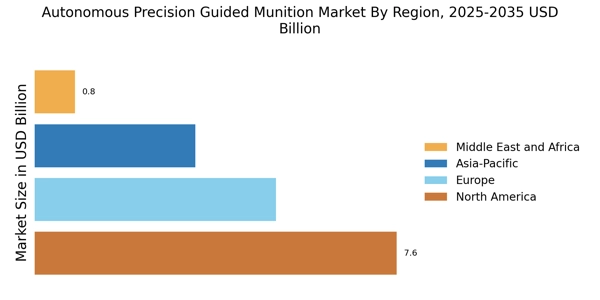Geopolitical Tensions
The Autonomous Precision Guided Munition Market is also shaped by rising geopolitical tensions among nations. Conflicts and territorial disputes have prompted countries to enhance their military capabilities, particularly in precision strike technologies. The ongoing arms race in various regions has led to an increased focus on developing autonomous munitions that can deliver precise strikes with minimal risk to personnel. This environment of uncertainty is likely to drive investments in autonomous precision guided munitions, as nations seek to deter potential threats and assert their military presence. Consequently, the market is expected to witness substantial growth as countries prioritize the acquisition of advanced munitions to address these challenges.
Increased Defense Budgets
The Autonomous Precision Guided Munition Market is experiencing a notable surge in defense budgets across various nations. Governments are prioritizing modernization of their military capabilities, which includes investing in advanced munitions. For instance, defense spending has seen an increase of approximately 3-5% annually in several countries, reflecting a strategic shift towards enhancing precision strike capabilities. This trend is likely to bolster the demand for autonomous precision guided munitions, as they offer improved accuracy and reduced collateral damage. As nations seek to maintain a competitive edge, the allocation of funds towards research and development in this sector is expected to rise, further propelling the market forward.
Technological Advancements
The Autonomous Precision Guided Munition Market is significantly influenced by rapid technological advancements. Innovations in artificial intelligence, machine learning, and sensor technologies are enhancing the capabilities of precision guided munitions. For example, the integration of advanced guidance systems has improved target acquisition and engagement, leading to higher success rates in military operations. The market is projected to grow at a compound annual growth rate (CAGR) of around 7-10% over the next few years, driven by these technological improvements. As nations invest in next-generation munitions, the demand for autonomous systems that can operate with minimal human intervention is likely to increase, shaping the future landscape of military engagements.
Emerging Military Strategies
The Autonomous Precision Guided Munition Market is being influenced by the evolution of military strategies that emphasize precision and efficiency. Modern warfare increasingly relies on the ability to conduct operations with minimal collateral damage, which has led to a growing preference for precision guided munitions. As military doctrines shift towards hybrid warfare and asymmetric tactics, the demand for autonomous systems that can adapt to dynamic combat environments is likely to rise. This shift in strategy is expected to drive the market, as armed forces seek to enhance their operational effectiveness while minimizing risks. The integration of autonomous precision guided munitions into military arsenals is anticipated to become a key component of future defense strategies.
International Collaboration and Partnerships
The Autonomous Precision Guided Munition Market is benefiting from increased international collaboration and partnerships among defense contractors and governments. Joint ventures and cooperative programs are emerging as nations recognize the advantages of sharing technology and resources. Such collaborations facilitate the development of advanced autonomous munitions, allowing for cost-sharing and accelerated innovation. For instance, partnerships between countries have led to the successful development of next-generation precision guided systems that leverage the strengths of multiple nations. This trend is likely to enhance the competitiveness of the market, as collaborative efforts can lead to more sophisticated and effective munitions, ultimately shaping the future of military capabilities.


















Leave a Comment